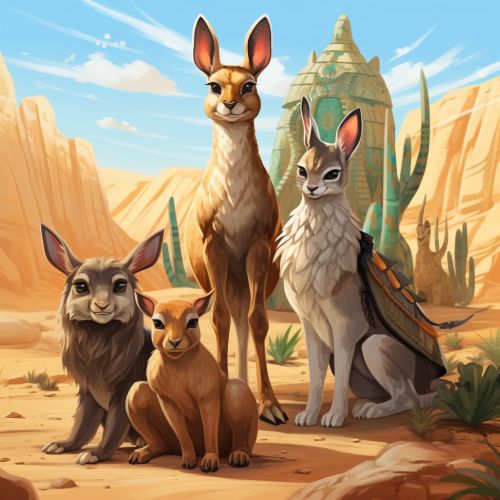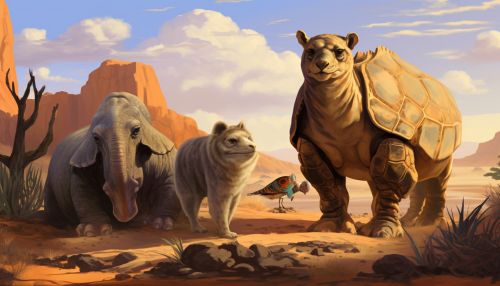Xerocoles
Introduction
Xerocoles are a group of animals that have adapted to survive in extremely dry, desert environments. These adaptations include physiological, behavioral, and morphological changes that allow these animals to conserve water, withstand high temperatures, and survive in conditions that would be lethal to most other organisms. This article will delve into the various types of xerocoles, their unique adaptations, and the role they play in desert ecosystems.


Types of Xerocoles
There are many different types of xerocoles, each with their own unique set of adaptations to desert life. These include mammals like the kangaroo rat, fennec fox, and dromedary camel, reptiles such as the desert tortoise and horned lizard, and birds like the sandgrouse and roadrunner. Insects, such as the desert locust, and arachnids, like the camel spider, are also considered xerocoles.
Physiological Adaptations
Xerocoles have developed a number of physiological adaptations to survive in desert environments. These adaptations help them to conserve water, withstand high temperatures, and extract the maximum amount of nutrients from their food.
Water Conservation
One of the most critical challenges for xerocoles is the conservation of water. Many xerocoles have developed the ability to produce highly concentrated urine, which reduces the amount of water lost during excretion. Some, like the kangaroo rat, can even metabolize the water in their food, allowing them to survive without drinking any water at all.
Temperature Regulation
Deserts can have extreme temperature fluctuations, from scorching heat during the day to freezing cold at night. To cope with these conditions, xerocoles have developed various methods of temperature regulation. For example, the fennec fox has large ears that help to dissipate heat, while the desert tortoise can burrow into the ground to escape the heat of the day and the cold of the night.
Nutrient Extraction
Desert environments are often nutrient-poor, so xerocoles have developed ways to extract the maximum amount of nutrients from their food. The desert locust, for example, has a highly efficient digestive system that allows it to extract nutrients from a wide variety of plant material.
Behavioral Adaptations
In addition to physiological adaptations, xerocoles also exhibit a range of behavioral adaptations that help them to survive in desert environments. These include changes in activity patterns, burrowing behavior, and the use of shade and wind for cooling.
Activity Patterns
Many xerocoles are nocturnal, meaning they are active at night and rest during the day. This allows them to avoid the extreme heat of the desert sun. Some xerocoles, like the roadrunner, are crepuscular, meaning they are most active during the cooler dawn and dusk hours.
Burrowing Behavior
Burrowing is a common behavior among xerocoles. By digging burrows, these animals can escape the extreme temperatures of the desert surface. Burrows also provide a humid environment that helps to reduce water loss.
Use of Shade and Wind
Xerocoles often use shade and wind to help cool down. For example, the horned lizard will often seek out shade under plants or rocks during the hottest part of the day. Some xerocoles, like the camel spider, will even construct their own shade by digging a small pit in the sand.
Morphological Adaptations
Xerocoles also exhibit a number of morphological adaptations that help them to survive in desert environments. These include changes in body size and shape, the development of specialized structures, and changes in coloration.
Body Size and Shape
Many xerocoles have a compact body shape, which helps to reduce water loss and heat gain. Some, like the dromedary camel, have a large body size that allows them to store more water and withstand longer periods of dehydration.
Specialized Structures
Xerocoles have developed a number of specialized structures to help them survive in desert environments. For example, the dromedary camel has a hump that stores fat, which can be metabolized to produce water. The kangaroo rat has specialized kidneys that allow it to produce highly concentrated urine, reducing water loss.
Coloration
Many xerocoles have a light coloration that helps them to reflect the sun's rays and stay cool. Some, like the desert locust, can even change their coloration depending on the temperature and humidity conditions.
Role in Desert Ecosystems
Xerocoles play a crucial role in desert ecosystems. They help to control the population of other organisms, contribute to nutrient cycling, and provide food for other desert-dwelling animals. Despite the harsh conditions, desert ecosystems are surprisingly diverse, and xerocoles are a key part of this biodiversity.
